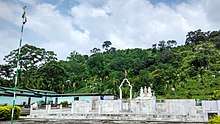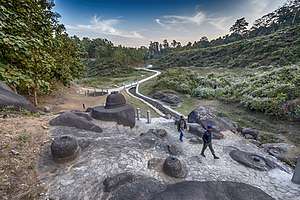Sri Surya Pahar
Sri Surya Pahar is located about 12 km southeast of Goalpara, about 132 km northwest of Guwahati, is a significant but relatively unknown archaeological site in Assam, India.[1] Bongaigaon is the nearest city from the site. The site is a hilly terrain where several rock-cut Shivalingas, votive stupas and the deities of Hindu, Buddhist and Jain pantheon are scattered in an area of about one km. The site is centered on the hills (Pahar) of Sri Surya which is profusely filled up with Shiva Lingas (Lingam).[2] The popular belief is that 99999 Shiva Lingas were engraved here by Vyasa in order to build up a second Kashi (where there were 1,00000 Shiva Lingas) and once it was one of the holiest pilgrimage sites in the region. There is no historical evidence exactly how many Lingams once dotted in these hills, but still there are hundreds of them, from tiny to large in size, scattered everywhere at the foot of the hill and covering the extensive area after centuries of neglect and pilferage. The exact figure of the Lingas (and also other deities and relics) in the hill is yet to be counted scientifically.
.jpg) Gateway of Surya Pahar | |
 Shown within India | |
| Location | Goalpara, Assam, India |
|---|---|
| Coordinates | 26°6′31″N 90°42′27″E |
| Type | Sanctuary |
A few years ago, some archaeologists unearthed a few Shiva Lingas and a few houses at Sri Surya — findings which confirmed the long-held belief that a thriving civilization held sway around Sri Surya Pahar some centuries ago. The intricate and scientific designs of the houses with artfully designed bricks led some archaeologists even to believe that more unearthing the history of Sri Surya Pahar would change the understanding of the history of ancient Assam and India. Some scholars even referred to the accounts of famous Chinese traveler Huen Tsang to claim that it was Sri Surya Pahar and not Guwahati that was the ancient land of Pragjyotishpur or Pragjyotisha Kingdom, the capital of the Kingdom of Kumar Bhaskara Varman (600-650). The findings of the nearby archaeological site of Paglatek are cited to strengthen this claim. Since Sri Surya Pahar is very close to the bank of Brahmaputra river, it might have been an important trade centre or seat of administration in the past.
Another important significance of Sri Surya Pahar is that it was once a confluence of three religions as evident from the innumerable sculptures and other relics belonging to Hinduism, Buddhism and Jainism.
Remains of Hinduism
.jpg)
.jpg)
The name of 'Sri Surya Pahar' implies that the site was perhaps associated with the cult of sun (Surya) worship. Literary accounts corroborate that among other Hindu deities worshipped in ancient Assam, 'Surya' (or the Sun God) occupied a prominent place in its cultural history. References are found in the Kalika-Purana (c.10th century) about two seats of sun worship in ancient Assam. One of the centres has been identified as Sri Surya Pahar which bears the iconographic significance of the cult as well.
Some archaeologists believe that a carved stone slab, now housed in the Sri Surya Temple and worshipped as ‘Surya’, may be the detached part that formed the ceiling of the temple of Surya. The central figure in the circular carvings of the slab has been identified as Prajapati, which is carved inside an inner circle while the surrounding outer circle is in the form of twelve lotus petals. Each lotus petal has the seated figure of an Aditya. These twelve Adityas are described as twelve solar divinities namely Dhatri, Mitra, Aryaman, Rudra, Varuna, Surya, Bhaga, Vivasvan, Pushan, Savitri, Tvastri and Vishnu.
Besides the numerous stone carvings of Shiva Lingas and the 'Prajapati' slab, there are many rock carvings of the Hindu deities which can be seen at the foothills of Sri Surya Pahar and its adjacent areas. Notable among them are the sculptural panels of Shiva and Vishnu. The twelve-armed Vishnu with a seven-hooded canopy over its head stands prominent. It is worshipped as Dasabhuja Durga. Adorned with necklace, kundalas, armlets, garlands, etc., the deity stands erect on a lotus.
There are differences among scholars about the identification of the twelve-armed 'Vishnu' sculpture. According to Dr Birinchi Kumar Baruah and Dr Srinivas Murthi, the sculpture is of Ma (mother) Manasha while the Archaeological Survey of India has identified it as a male deity which was tempered with thick plaster into a female one subsequently. There is a series of rock carvings on either side of this prominent figure. The notable remains are the Ganesha, Hari Hara (or Harihara), Vishnupadas, etc. Most of these carved figures are assigned to circa 9th century AD. Similar to the Surya Chakra, there also exists a 'Chandra Chakra', but the natural vagaries have eroded it badly.
Jain Heritage

Jainism could not get any remarkable footing in the North-East region of India throughout its long history. Except for the solitary example existing inside the natural caves at Sri Surya Pahar, hardly any other Jain remains have been found so far in the region. It was probably the followers of Rasbhanath whose foot prints are also at Sri Surya Pahar. The iconography of jain images found here is little different near their hands, but are found naked as per jain's traditional iconography.
On the southern slope of Sri Surya Pahar, there is a natural cavern made of piled stones. Within the natural caves, there are Jain carvings. Remains of these Jain affiliations in the form of inscription and rock carvings are assigned to the 9th century AD. There are two figures carved in a big granite boulder which are in low relief. The figures are shown in standing posture with their hands hanging down to the knees and their cognisance are shown below the figures in low relief. Another figure carved at the top of the hill is identified as Adinath. The figure is carved in sitting posture in the rocky outcrop and two bulls are marked at the base, the mark of cognisance of the first Tirthankara. These figures are also believed to be of the 9th century AD.[3]
Buddhist Remains
On a vast area right from the extreme northwestern slope of the Sri Surya Pahar hill up to one kilometer further south, there are found as many as 25 votive stupas of different shapes and sizes cut out of granite boulders. These stupas are significant for it shows two points: firstly, there was Buddhist influence in ancient Kamarupa. It is in contrast with the commonly held belief that Buddhism was not prevalent in the cultural history of ancient Kamarupa. Secondly, the Buddhist influence in ancient Kamarupa was much earlier than in the rest of the country.
On the extreme north east corner on a higher altitude, a huge fallen granite boulder was selected for carving three giant stupas, carved in one row, facing the east. The structural feature of the stupas consist of Vedi, Medhi Anda & Harmika which are distinct. The stupas are archaic in shape with three gradually receding rings round the base. The topmost ring that supports the dome is almost semicircular in shape with flattened top. On the top of the dome there are the remnants of a square ‘harmika’ with groove in the centre to hold the shaft of 'chhatra' or 'chhatravali' (parasol). The crowning element is, however, missing. The three monolithic stupas are representative of either Dharma, Sangha & Budha or they could be termed as Uddeshika stupa carved in the memory of Lord Buddha.
According to the Archaeological Survey of India, the archaic shape of the carvings shows that the stupas at Sri Surya Pahar were hewn during the Hinayana phase of Buddhism of early Christian era. Further development of the faith in the later phases is not yet seen at the site. Later phases of Mahayana and Vajrayana esotericism were seen in the neighbouring territories of Bihar and Bengal.
An interesting feature of the stupa complex is that in the 9th-10th century A.D., when the area was pre-occupied by the followers of Hindu pantheons, attempts were made to carve Siva Lingas along with Younipith and channel spout on fallen boulders. Altogether half a dozen Siva Lingas exist there .
One Elliptical stupa was also carved on a smaller boulder lying within two huge boulders is an interesting piece of Art, as this elliptical shape is very rare in Eastern India. One of such stupa found at Langudi in Jaipur district of Orissa dates back to the 1st A.D.
The stupas and also the terracotta plaques with figure of Buddha found in regular excavation indicate that Buddhism flourished in lower Brahmaputra valley, especially in and around Surya Pahar during the early part of the Christian Era and continued up to the 10th Century A.D. In the 9th- century A.D.the Pala Dynasty (who were followers of the Mahayana and Tantric schools of Buddhism) stretched to a large part of India including Assam resulting in spread of Buddhism throughout the length and breath of Brahmaputra Valley (undivided Assam). Buddhist remains found in some nearby areas like Pancharatna, Barbhita village and Bhaitbari (now in Meghalaya) in the southern Bank of the lower Brahmaputra valley also strengthen the fact.
Excavations
_Notice_Board.jpg)

Archaeological Survey of India (ASI) started excavation works in Sri Surya Pahar in 1993. But the initial works were carried out for brief periods annually which, however, exposed startling relics including heads of deities with Karanda Mukuta, Kirtimukha, vestiges of stupa, terracotta mortar-pestle and vessels used in rites, designed tiles, Apsaras, Purnaghat, etc.
Excavations carried out in 1996 and 1997 hit gold when archaeologists discovered a Buddhist stupa along with monastery (vihara) which were estimated to belong to the 8th-9th century AD (contemporary to Paharpur stupa now in Bangladesh).
Excavations carried out in later years also yielded two temple complexes one of which was a brick temple complex aligned in north-south directions. These rectangular enclosure walls enclose the remains of several brick structures including the sanctum sanctorum and porch built in three substructural phases. The excavators also found a number of antiquities at the site most of which were terracotta tiles and plaques. Remarkable discoveries from the temple complex near the ancient tank include sculpture of Ganesha and Mahishasuramardini.
In the southern foothills of Sri Surya Pahar, excavators found a stone-paved water kund with revetment walls. This type of ancient kund which can control the natural flow of water has been found at many archaeological sites spread over India. This kund found at Sri Surya Pahar was probably used to take bath and to perform other daily ablutions by the devotees and monks before going to worship the Jain god which was carved in the natural cavern.
ASI founded a museum at the site to exhibit most of the antiquities unearthed from the excavation. Some of these 96 collections displayed at the site museum include stone sculptures of Gajasimha, Mahishasuramardini, decorated lion head, moulded fish, plaques of the human figure, mythical animals, kiritimukhas, amalaka fragment, decorated tiles of floral and geometric designs, etc.
References
- "Surya temple,Surya pahar temple,Surya pahar,Assam". Religiousportal.com. 1 January 1980. Retrieved 29 March 2013.
- "Surya Pahar, Goalpara | Surya Pahar Photos | Goalpara Tourist Places". Holidayiq.com. Retrieved 29 March 2013.
- Prakash, Col Ved (2007), Encyclopaedia of North-East India, 1, Atlantic Publishers & Dist, p. 374, ISBN 9788126907038
- Choudhary, R. D. (1998), Art Heritage of Assam, Aryan Books International
- Buruah, B. K. (1988), Temples & Legends of Assam, Bharatiya Vidya Bhavan
External links
| Wikimedia Commons has media related to Sri Surya Pahar. |